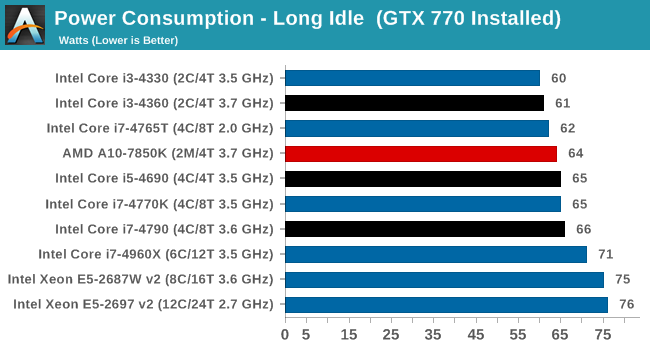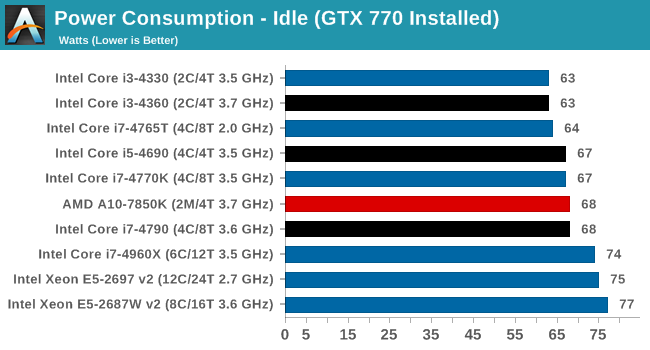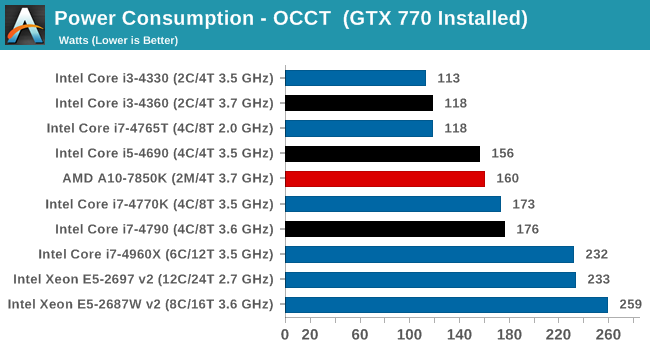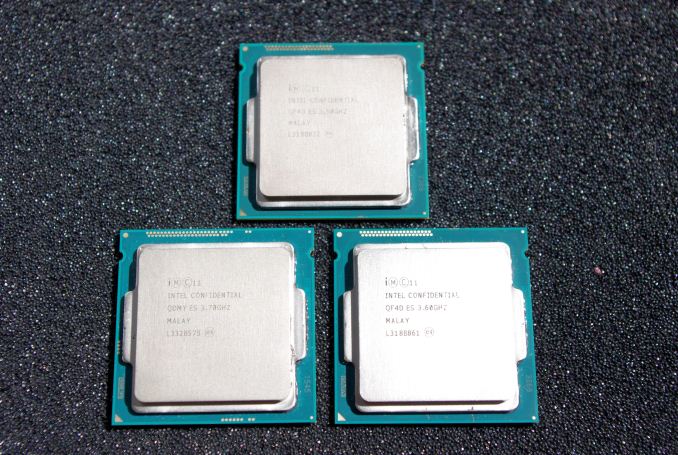The Intel Haswell Refresh Review: Core i7-4790, i5-4690 and i3-4360 Tested
by Ian Cutress on May 11, 2014 3:01 AM ESTThe Haswell Refresh Processors
As a species that thrives on getting things done quicker or cheaper, a processor refresh should be welcomed. For the refresh, Intel is launching a total of 42 new SKUs, 24 of which are desktop but not all of them will make it into the land of retail. Prices for batches of a thousand will range from $42 to $303 on the desktop and $75 to $434 in mobile. Cutting to the chase, the new desktop SKUs are:
| Intel Haswell Refresh CPU List (Desktop) | ||||||||
| New SKU | Cores | Base | Turbo | L3 Cache | IGP | TDP / W |
Intel List Price |
|
| Celeron G1840 | 2 / 2 | 2800 | - | 2 MB | HD (Haswell) | 53 | $42 | |
| Celeron G1840T | 2 / 2 | 2500 | - | 2 MB | HD (Haswell) | 35 | $42 | |
| Celeron G1850 | 2 / 2 | 2900 | - | 2 MB | HD (Haswell) | 53 | $52 | |
| Pentium G3240 | 2 / 2 | 3100 | - | 3 MB | HD (Haswell) | 53 | $64 | |
| Pentium G3240T | 2 / 2 | 2700 | - | 3 MB | HD (Haswell) | 35 | $64 | |
| Pentium G3440 | 2 / 2 | 3300 | - | 3 MB | HD (Haswell) | 53 | $75 | |
| Pentium G3440T | 2 / 2 | 2800 | - | 3 MB | HD (Haswell) | 35 | $75 | |
| Pentium G3450 | 2 / 2 | 3400 | - | 3 MB | HD (Haswell) | 53 | $86 | |
| Core i3-4150 | 2 / 4 | 3500 | - | 3 MB | HD 4400 | 54 | $117 | |
| Core i3-4150T | 2 / 4 | 3000 | - | 3 MB | HD 4400 | 35 | $117 | |
| Core i3-4350 | 2 / 4 | 3600 | - | 4 MB | HD 4600 | 54 | $138 | |
| Core i3-4350T | 2 / 4 | 3100 | - | 4 MB | HD 4600 | 35 | $138 | |
| Core i3-4360 | 2 / 4 | 3700 | - | 4 MB | HD 4600 | 54 | $149 | |
| Core i5-4460 | 4 / 4 | 3200 | 3400 | 6 MB | HD 4600 | 84 | $182 | |
| Core i5-4460S | 4 / 4 | 2900 | - | 6 MB | HD 4600 | 65 | $182 | |
| Core i5-4590 | 4 / 4 | 3300 | 3700 | 6 MB | HD 4600 | 84 | $192 | |
| Core i5-4590S | 4 / 4 | 3000 | 3700 | 6 MB | HD 4600 | 65 | $192 | |
| Core i5-4590T | 4 / 4 | 2000 | - | 6 MB | HD 4600 | 35 | $192 | |
| Core i5-4690 | 4 / 4 | 3500 | 3900 | 6 MB | HD 4600 | 84 | $213 | |
| Core i5-4690S | 4 / 4 | 3200 | 3900 | 6 MB | HD 4600 | 65 | $213 | |
| Core i5-4690T | 4 / 4 | 2500 | - | 6 MB | HD 4600 | 45 | $213 | |
| Core i7-4785T | 4 / 8 | 2200 | - | 8 MB | HD 4600 | 35 | $303 | |
| Core i7-4790 | 4 / 8 | 3600 | 4000 | 8 MB | HD 4600 | 84 | $303 | |
| Core i7-4790S | 4 / 8 | 3200 | 4000 | 8 MB | HD 4600 | 65 | $303 | |
| Core i7-4790T | 4 / 8 | 2700 | - | 8 MB | HD 4600 | 45 | $303 | |
Every new desktop processor is a 100-200 MHz upgrade from the one named xx2x lower but at the same price point. Back when the initial processor price lists were announced, I made different comparisons from Celeron to i7 depending on what was relevant. For example, in the Celeron category:
| Haswell Celeron | ||
|
Celeron G1840 2.8 GHz (New) |
Celeron G1830 2.8 GHz (Current) |
|
| CPU Speed | 2.8 GHz | 2.8 GHz |
| Cores | 2 | 2 |
| Threads | 2 | 2 |
| L2 Cache | 512 KB | 512 KB |
| L3 Cache | 2048 KB | 2048 KB |
| IGP | HD (Haswell) | HD (Haswell) |
| IGP Frequency | ? | 1050 |
| TDP | 53W | 53W |
| Price at Launch | $42 | $52 |
Here we already have a Celeron processor with the exact same speed as one of the Haswell Refresh SKUs, but because it has been on the market for longer it is actually cheaper while providing the same specifications.
At the top end i7, the i7-4790 should actually be a replacement for the i7-4771 which was released in September 2013:
| Haswell Core i7 | ||
|
Core i7-4790 (New) |
Core i7-4771 (Current) |
|
| CPU Speed | 3600 MHz / 4000 MHz | 3500 MHz / 3900 MHz |
| Cores | 4 | 4 |
| Threads | 8 | 8 |
| L2 Cache | 1024 KB | 1024 KB |
| L3 Cache | 8192 KB | 8192 KB |
| IGP | HD 4600 | HD 4600 |
| IGP Frequency | 350 / 1200 MHz | 350 MHz / 1200 MHz |
| TDP | 84W | 84W |
| Price at Launch | $303 | $314 (OEM) / $320 (box) |
By releasing new mainstream processors into the desktop market, as well as the 9-series chipsets, Intel has afforded the system integrators another chance to sell newer systems and not to stagnate with older models.
For most of the performance enthusiasts reading this review, the question you might well be asking yourself relates to the Haswell Refresh overclockable CPU. At this point in time it is clear that the i5-4670K and i7-4770K models do not have refresh counterparts, both of which are also more marketable to system integrators as well as desired by home users. There is a simple explanation to this.
Nothing fundamentally changes with these refresh processors. It is the same design underneath. Now that Intel has been making Haswell wafers, the process is slightly more efficient over time (ironing out production) and the processor bins can all be shifted. If Intel were to release new overclockable CPUs that were a simple speed bump but ultimately had no performance gain of the current overclocking CPUs, there might be a backlash.
To that end, Intel is going to release ‘Devil’s Canyon’ in due course. Devil’s Canyon has no official SKU name yet (i7-4970K or i7-4770X are my best guesses) but it was announced back in March as having an improved package and better thermal interface material. It will probably be the same silicon underneath as the i7-4770K due to the nature of the refresh, perhaps with a small design tweak that does not require new masks. We will review the new overclocking processor when we receive a sample from Intel, hopefully under something suitably extreme.
Today’s Review: The Intel Core i7-4790, i5-4690 and i3-4360
Back when Haswell was launched, we had only the chance to test the top line overclocking processor, the i7-4770K. This time around I was thankful to get the opportunity to expand our testing to the i5 and i3 segments of the processor line to find where they each stand in terms of performance. For comparison points we have the i7-4770K from our launch review, an i7-4765T from our ASRock M8 review, and an i3-4330 we picked up along the way.
| The Intel Haswell Refresh Review | ||||||
|
Core i7-4790 (New) |
Core i7-4770K | Core i7-4765T |
Core i5-4690 (New) |
Core i3-4360 (New) |
Core i3-4330 | |
| Price | $303 | $340 | $303 | $225 | $149 | $140 |
| Launch | 5/2014 | 6/2013 | 6/2013 | 5/2014 | 5/2014 | 9/2013 |
| Cores / Threads | 4/8 | 4/8 | 4/8 | 4/4 | 2/4 | 2/4 |
|
Base Frequency |
3600 | 3500 | 2000 | 3500 | 3700 | 3500 |
|
Turbo Frequency |
4000 | 3900 | 3000 | 3900 | - | - |
| IGP | HD 4600 | HD 4600 | HD 4600 | HD 4600 | HD 4600 | HD 4600 |
|
IGP Frequency |
350 | 350 | 350 | 350 | 600 | 350 |
| IGP Turbo | 1200 | 1250 | 1200 | 1200 | 1150 | 1150 |
| L3 Cache | 8 MB | 8 MB | 8 MB | 6 MB | 4 MB | 4 MB |
| TDP | 84 W | 84 W | 35 W | 84 W | 54 W | 54 W |
Assuming all goes as planned, the small increases in frequency should provide a ~3% increase in benchmarks compared to the older Haswell processors.
Multi-Core Enhancement Isn’t Much Of An Issue
CPU benchmarking can be a bit of a nightmare in the current climate, especially on Intel platforms where turbo modes are possible. Back in 2012 I wrote an extensive news piece about Multi-Core Enhancement titled ‘The Debate About Free MHz’, wherein it is not actually Intel that set the CPU frequency for the processors but the motherboard. Where Intel might have a 3500 MHz base frequency and a 3900 MHz turbo frequency, a motherboard can detect that setting and override it for 3900 MHz on all cores by default. One motherboard went as far as increasing the multiplier +1 over the Intel specifications. The upshot of this is in multi-threaded performance benchmarks, where due to the extra frequency the final result is higher than Intel specifications. MultiCore Enhancement also means that the same CPU in different motherboards will give different results out of the box.
Most motherboard manufacturers that use this tactic (MSI, ASRock, GIGABYTE and ASUS all have this feature), as far as I can tell, limit the option to overclockable SKUs, and it is only implemented when XMP is implemented.
On top of this, Windows can also be a culprit. In different power modes, users can specify the percentage of maximum CPU frequency depending on what power mode is in play. This relates more to portable devices, but it is configurable with desktop systems as well.
For our review, as we only have one overclockable CPU in the test, we can adjust appropriately. For our testing we actually run SYSMark 2014 as our first benchmark, as the install prefers a fresh OS image to work with. This generates a consistent power profile which we maintain for the rest of the benchmarks. Had we run SYSMark mid-way through our testing period, it may have ended up with variable results, so we aim to keep our environment consistent and maintainable.
Test Setup
We would like to thank the following companies for providing test-bed support:
Thank you to OCZ for providing us with PSUs and SSDs.
Thank you to G.Skill and ADATA for providing us with memory kits.
Thank you to Corsair for providing us with an PSU, CLC and memory.
Thank you to ASUS for providing us with the AMD HD7970 GPUs and some IO Testing kit.
Thank you to MSI for providing us with the NVIDIA GTX 770 Lightning GPUs.
Thank you to Rosewill for providing us with keyboards.
Thank you to ASRock for providing us with the 802.11ac wireless router for testing and other components.
| Test Setup | |
| Processor |
Intel Core i7-4790 ES (4C/8T, 3.6 GHz to 4.0 GHz) Intel Core i5-4690 ES (4C/4T, 3.5 GHz to 3.9 GHz) Intel Core i3-4360 ES (2C/4T, 3.7 GHz) |
| Motherboards |
ASRock Z97 Extreme6 ASUS Z97-Deluxe |
| Cooling |
Corsair H80i Thermalright TRUE Copper |
| Power Supply |
OCZ 1250W Gold ZX Series Corsair AX1200i Platinum PSU |
| Memory |
G.Skill RipjawsZ 4x4 GB DDR3-1866 8-9-9 Kit ADATA XPG 2x8 GB DDR3L-1600 9-11-9 Kit |
| Memory Settings | 1600 9-11-9-27 1T tRFC 240 |
| Video Cards |
MSI GTX 770 Lightning 2GB (1150/1202 Boost) ASUS HD7970 3GB (Reference) |
| Video Drivers |
Catalyst 13.12 WHQL NVIDIA Drivers 335.23 WHQL |
| Hard Drive | OCZ Vertex 3 256GB |
| Optical Drive | LG GH22NS50 |
| Case | Open Test Bed |
| Operating System | Windows 7 64-bit SP1 |
Following recent reviews, we have added several new benchmarks to our testing, including SYSMark and Unity-based testing methodology. At present we have only tested a few CPUs on these new benchmarks.
Power Consumption
For our power consumption tests, we take the system as a whole with a GTX 770 installed and test at idle, long idle (monitor turned off by the OS) and OCCT (artificial CPU load). We use the same PSU to keep efficiency on the same scale, although some of the data points are sub-20% efficienct for our power supply. This means that arbitrarily the qualitative comparison is more important than the quantitative comparison. Also of note is the Z97 motherboard we used for these tests implements an Adaptive voltage profile, meaning that artificial loads such as OCCT push the voltage higher than normal, increasing power consumption at load. Nevertheless the order of the results indicates a pattern from low power to high power.



As expected, the 84W i7-4790 requires the most power, similar to the i7-4770K and i5-4690 that are also 84W.












130 Comments
View All Comments
name99 - Sunday, May 11, 2014 - link
"For longer cadences it makes sense to launch an improved product in the middle of that cadence taking advantage of minor production improvements."Nice save, Ian, but let's be honest here. This product is being launched for one, and only one reason --- Broadwell is delayed, and this is the best Intel can do to fill the gap and quieten the anger from customers (like Apple) who've had to delay all their plans because of the Broadwell slip.
GuardianAngel470 - Sunday, May 11, 2014 - link
On page two: "At this point in time it is clear that the i7-4670K and i7-4770K models do not have refresh counterparts..."That first i7 seems to be an i5 in disguise. You may want to beef up your internal security, it seems you have been discretely infiltrated.
Ian Cutress - Monday, May 12, 2014 - link
Nice catch :) Fixed!meacupla - Sunday, May 11, 2014 - link
I only care about that 20th anniversary edition Pentiumhojnikb - Monday, May 12, 2014 - link
Yep, me too :)Ramon Zarat - Sunday, May 11, 2014 - link
LMAO... My ASRock Z68 Extreme4 GEN3 from 2011, 4 generations behind this Z97, offers me 98%+ of the functionality and speed!Ok, I have a moded BIOS to get my 2 X SSD to run in RAID0 (man, I hate artificial market segmentation) and get well over 900MB/s sequential read, but beside that, NOTHING revolutionary from Intel Z97 to make wish to upgrade from what I already have!
Already got plenty of USB3 ports with 4 total (only a handful of devices can actually use full USB3 speed anyway), the PCIe lanes from the GPU are already GEN3 thanks to ASRock GEN3 series, I have a much more flexible I/O hub/switch (PLX PEX8608) for the 8 X PCIe 2.0 lanes from the south bridge, so EVERYTHING is concurrently *LIVE* (gigabit Ethernet, USB3, *ALL* PCIe lanes etc...), so need to choose a limited setup and call it "flexible" LOL...
2 X SATA 6Gb/s for my 2 SSDs is enough, as the other 4 SATA 3Gb/s are also more than enough for mechanical hard drives. I don't see HDD busting the 3Gb/s barrier anytime soon. I even have a Marvell SATA controller on top for either e-SATA or 2 X internal optical drives. Also, I'm already booting from SSD, so the PCIe SSD booting mean nothing to me. From cold start to login screen in less than 25 seconds and I always put the computer to sleep anyway, so boot time is actually less than 3 second 99% of the time so that EUFI fast boot also means nothing to me.
With a 4.7Ghz quad core CPU and 16GB of 1600Mhz CL8 RAM, I'll keep this rig for a long, long LONG time! The only upgrade I see in 4-5 years is maybe 2 larger SSDs and a maybe a new DX12 video card when they become cheap AND plenty of games requires DX12. We have been GPU limited for a long time now and I don't see that changing 5 years from now where my current CPU will still be more than enough to push a DX12 GPU @ 1080p (I won't switch to 4K resolution before my next PC in 7-10 years from now).
The desktop might not be dead, but it surely reached a point where it's so powerful, it's good enough for so many things you do, you actually don't need to upgrade every 36 months anymore.
For example, MP3 are now converted practicality instantaneously and HD content only take a few minutes. You can do HUGE spreadsheets calculation is mere seconds, Photoshop effects as well etc... One of the only thing still too CPU intensive is Hollywood grade 3D rendering and for that, we now use rendering farms with GPGPU, local or in the cloud, tens of thousand of time faster than any desktop.
I have the feeling my next PC will not be a silicon based technology!
wetwareinterface - Sunday, May 11, 2014 - link
you have 2x ssd's in raid 0 claiming 900MB/s and your boot time tot login screen is under 25 seconds?i have a single older samsung 240 non pro/evo 250 GB drive and my boot time to desktop with all drivers loaded and internet connected is, after manually logging in btw, around 15 seconds.
maybe you shouldn't dismiss an upgrade too quickly
wetwareinterface - Sunday, May 11, 2014 - link
that's a cold boot time alsoRamon Zarat - Monday, May 12, 2014 - link
Well, that's 1 big difference right there; you don't boot in RAID mode, therefore you don't have the ~5 seconds RAID BIOS screen to go through as I do! Single SSD drives are practically always faster to boot compared to RAID0 SSD for that reason alone, but:I have a lot of stuff installed on an old (3+ years) Win 7 install. That makes the boot take more time. Also, the boot process involve a lot of small files, making the RAID0 less efficient (files smaller than the strip size are loaded from 1 drive instead of 2) and finally, my older Crucial M4 single drive performance is slower than your more recent Samsung that I guess is the 840 (AFAIK, there is no such thing as the Samsung 240 SSD), especially for writing. You don't mention it, but Windows 8 usually boot faster than the 7 that I use. My guess is you have a fresh Windows 8.1 install. All this explain the other ~5 seconds from my 25 to your 15.
One thing I can assure you, I'm launching games and app with larger sequential files size a lot faster than your single Samsung drive, especially because I also use a 5GB RAM drive for all my system tmp and temp folder (incredible speed boost for Photoshop Scratch disk for example). CrytalDiskMark doesn't lie.
I guess my point is, 90% of my SSD access patterns are medium/large size reads, not writes (install game/app once, play/use hundreds of times) and I re-boot my PC once every 2-3 weeks or so to "refresh" the system from a clean cold boot and it take only 25 sec. I sneeze 2-3 times in a row and I miss the boot process entirely! This is nowhere near the "it's so time consuming, I MUST upgrade" scenario. Every other time I boot, which is 95% of the time in fact, it's 3 seconds from sleep... So no, I really don't *NEED* to upgrade.
I once endured stuff like 5-10 *MINUTES* boot time with Windows 95-98, so I'll go along with 25 seconds just fine! I used to power up my PC in the morning, then getting my coffee and 2 toasts, and when I done eating my breakfast, the PC just made it to the login screen! :) Ahhhhh, the good old days of running Windows 95 from an AMD 486DX/4-120 and a 5400RPM HDD!
Just like I've said, I won't need to upgrade for a long, long time!
Flunk - Monday, May 12, 2014 - link
That's your problem right there, if you're running Windows 7 that's going to kill your boot time right there. Even my laptop that only has a Sandforce mSATA drive boots in 7 seconds using Windows 8.